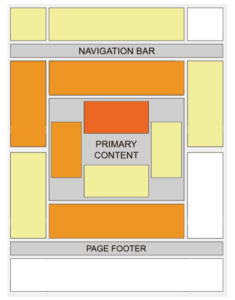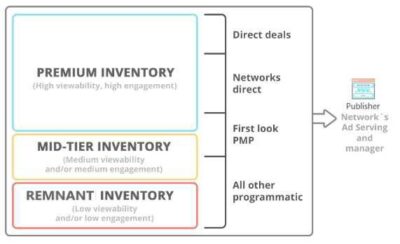How to Determine the Value of Your Ad Inventory
Car dealerships do lot checks to calculate the value of their car inventory, and banks do audits to calculate the value of their cash inventory, but how do ad publishers calculate the value of their ad inventory?
Advertising is a major source of income for most online businesses, so understanding and determining the value of your ad inventory is a critical activity for any business trying to succeed in the 21st century.
Without specialized tools, coordinating ad sales and calculating ad inventory would be a nightmare. Thankfully, platforms like Salesforce specialize in converged ad management that gives companies a complete view of their advertising activities, whether they’re advertisers or publishers. Rainmaker helps companies integrate their business with Salesforce’s family of software, taking the guesswork out of Salesforce integration and service management.
Defining Ad Inventory
In the digital advertising ecosystem, buying and selling ad spaces is complicated, but platforms like Salesforce help advertisers coordinate this effort across various ad channels. Simply put, ad inventory is the space publishers can sell to place advertisements.
For example, the pre-roll ads on a YouTube video, the banner space above a blog, and the sponsored search results on Etsy are all examples of ad inventory for their respective publishers.
Because ad inventory can look so different from example to example, measuring the value of ad inventory is especially difficult. To add complication, ad placement also drastically influences the value of ad inventory.
This heat map shows which ad spaces are most valuable based on how likely users view the ad. Ads in the upper center of the page occupy prime real estate, while ads at the very bottom of the page are likely to receive much less attention.

Types of advertising channels
Advertising is as old as commerce. For most of formal advertising’s history, an advertisement was a printed message on a sign, newspaper, or bulletin, so tracking inventory was as easy as counting the number of printed ads. In the last 100 years, however, radio, television and the internet drastically changed how people consume ads.
Video advertising
Historically, video advertising meant linear TV ads, but in the modern day, video ads encompass everything from YouTube, streaming services and social media.
Linear TV is broadcast television that follows a set (“linear”) schedule. This presents an advantage for measuring ad inventory because advertisers can schedule ads at certain times alongside certain programming, making ad inventory easy to manage. However, it’s not all upsides as there is no reliable way to track viewership as the overwhelming majority of television viewers don’t watch advertisements at all, opting to use their DVR to fast-forward through commercials or simply take a bathroom break or pick up a phone during the break.
Ad inventory for video advertising in the current day still includes linear TV ads, but it has expanded to include digital video—everything from advertisements on streaming services, pop-up video ads on websites, and sponsored content on TikTok and other platforms.
Influencer marketing
While you may think of influencer marketing as a fad, consider this surprising fact: nearly half of all consumers depend on influencer recommendations. While celebrity endorsements are nothing new, 70% of teenagers trust influencers more than celebrities, and 40% of millennials say their favorite influencers understand them better than their closest friends.
In light of those facts, it’s no surprise that approximately two-thirds of marketers plan to increase their influencer marketing spending. Some marketers are seeing returns of as much as $18 for every $1 spent on influencer marketing.
Influencer marketing primarily takes place on social media platforms like Instagram and TikTok, but there’s a large overlap between influencer marketing and digital video ad channels—many advertisers feature influencers in videos that appear on other websites.
Podcasting
It’s no secret that podcasts have taken the world by storm, and sponsors’ ads fund nearly every one of those podcasts. After all, with the number of listeners projected to surpass half a billion in the next few years, and with very few of those listeners paying directly to listen to a particular podcast (aside from voluntary contributions through platforms like Patreon or Ko-fi), podcasts generate most of their revenue through sponsored ads.
Traditional marketing channels
While new forms of media have taken the advertising world by storm, the print and out-of-home advertising industries are far from becoming irrelevant. Newspapers and magazines continue to be advertising powerhouses, billboards pop up beside every major road, and new players like social media are becoming significant components of most ad strategies.
However, in these more traditional marketing channels, the social media platform, publication or billboard agency controls the ad inventory directly. For that reason, it’s unlikely that these other forms of media will be components of your ad inventory—for most publishers, banner ads and digital video will make up most of your ad inventory.
Determining ad inventory value
With all these advertising channels to consider, calculating an accurate value for your ad inventory depends on more than a few factors. How many ad spots do you have? How high is the demand? How much traffic will you receive? What are advertisers willing to pay? What mix of ad channels do you offer?
To simplify this process, ad publishers separate their ad inventory into tiers: premium inventory, mid-tier inventory, and remnant inventory.
- Premium inventory is the best you have to offer. Premium inventory is the banner ads, pre-roll videos and sponsored influencer marketing posts you can offer to advertisers. Since these are the most valuable types of ad inventory, they also command the highest prices. Premium inventory mostly comprises established relationships between trusted publishers and advertisers.
- Mid-tier inventory is less valuable than premium inventory but still valuable to advertisers. Mid-tier inventory waxes and wanes based on your web traffic and desirability, but it is still a seller’s market.
Remnant inventory is mostly programmatic advertising, meaning it is less curated and personalized. The most popular publishers may not have any remnant inventory at all (think Super Bowl commercials—there are no low-demand commercial slots), but content farms and less popular websites may have more remnant inventory than premium and mid-tier.

Determining ad inventory value requires estimating how much your ad inventory will fall into each category and how much you can charge for each tier. For example, if you anticipate receiving 2 million visits to your website in a particular month and you believe that premium advertisers will take up 70% of your ad inventory, paying $5 CPM (cost per thousand impressions), 20% will be mid-tier advertisers paying $3 CPM, and the remaining 10% will pay $1 CPM for remnant inventory, then your average CPM is $4.20.
To calculate this, simply add ($5 x 70%), ($3 x 20%), ($1 x 10%) together to reach the total average of $4.20 CPM. If you have multiple ad channels, these percentages will further segment into video ads, banner ads, sponsored blog posts, etc.—whatever best suits your business model.
If you have 15 ad spaces making an average of $4.20 per thousand impressions and anticipate 2 million visits to your page, then all you have to do is multiply 2 million visits by 15 ad spaces for a total of 30 million impressions. Remember that CPM is cost per THOUSAND impressions, so if your CPM is $4.20, divide that number by 1,000 to calculate the cost per single impression of $0.0042.
From here, you know your total number of impressions is 30 million, and you know the cost per impression is $0.0042, so multiply those numbers together to arrive at the total value of your ad inventory: $126,000.
Rainmaker Salesforce Managed Services
Managing your ad inventory requires some specialized knowledge and some serious dedication but doing it all yourself isn’t your only option.
Rainmaker takes the guesswork out of your Salesforce integration. Rainmaker specializes in the technical components of Salesforce managed services, so you can spend less time trial-and-erroring your way through ad inventory and more time doing what you do best.
If you’re ready to take charge of your platform and take the next step in your Salesforce journey, schedule a meeting with Rainmaker to learn how they can help.






